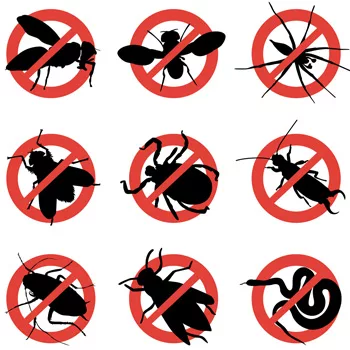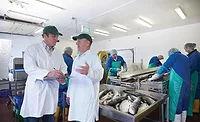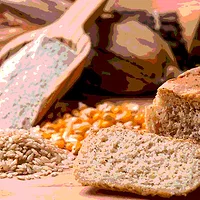What “Bugs” Sanitarians about IPM

I have not previously ventured into the topic of pest control because it hadn’t seemed to be much of a problem in food processing lately, at least not to the degree we knew in the past. However, over the last decade, I, along with many of my fellow sanitarians, have noticed an increase in pestilence incidents in retail food establishments (including grocery stores, farm markets, restaurants and bars and all institutions). While these sporadic problems do not often rise to the level of a public health catastrophe, they do cause one to raise an eyebrow.
Since most, if not all, pest control firms are selling their services as integrated pest management (IPM), there shouldn’t be occasional “flare-ups” if the service is done correctly. However, we do see the occasional glitch in the system when IPM devolves from prevention to intervention and the integrated management portion of the program becomes mere control. Why this happens has been niggling at me for quite some time, but it is quite obvious that the answer lies somewhere between economics and public acceptance.
My introduction to IPM was sometime in the mid 1960s when it was just coming into its own. By the 1980s, IPM had become the norm in our industry, and there was considerable information in professional and trade journals as well as conference presentations. IPM was, for the most part, universally accepted as the right way to control pests. The sprayer had given way to the caulking gun and traps. It was a great idea then, and it has only gotten better with age. The horrific infestations we used to see as commonplace occurrences are no more. However, there are notable, albeit minor, exceptions.
As with anything that has been around for a while, we find certain emphasis and responsibility shifting as part of a normal aging process. Over the past decade, those of us in the regulatory industry have noticed more frequent instances of complacency towards pest control and a relaxation of the tenets of IPM by all stakeholders: restaurant operators, pest control services and, much to our chagrin, our own inspection processes. I guess this is the result of the fantastic successes we have realized in pest reduction over the past 40-plus years.
Whose Job Is It?
Whereas at one time the retail food establishment took an active role in IPM, it has relegated this activity more and more to the pest control service. The monthly call reports are dutifully filed, the bills are paid, the contracts are automatically renewed or extended and the “preventive” part of pest control has devolved into a once-a-month passive occurrence with the visit of the pest control technician. In short, much of the retail food industry has stepped back from actively participating in its own pest management and shifted the burden onto a contracted agency. Many agreements between the pest control service and the retail food establishment have become dated boilerplate contracts that no longer represent the scientific advancements now available or reflect the needs of the retail food establishment. This complacency has shifted the pest control paradigm from performance to price. On the rare occasion when an infestation becomes a reality, everyone wonders why the problem wasn’t recognized sooner.
For the most part, pest control service providers go about their business in an efficient manner. Once the initial pestilence problems are identified and dutifully controlled, the “management” portion of IPM morphs into “maintenance.” More often than not, the detailed checksheet reports submitted by the technician consist of nothing more than the word “OK,” supported by initials and a date. The active dialogue that once was part of the contractual service becomes a mere validation of attendance. While emphasis is still given to the prevention of cockroaches and rodents, intervention has become the norm in the control of flies, filth flies, stored-product pests, stinging arthropods, ants, spiders and fleas. I cannot recall the last time I reviewed a report in which these were part of a prevention program or where mosquitoes, ticks, landscaping or structural pests were mentioned. To the best of my knowledge, IPM does not—or should not—end at the establishment’s threshold.
My fellow professionals have all but abandoned the dogmatic pursuit of pestilence in our inspections and most often rely on an actual “sighting” as a violation, with an occasional mention of door sweeps and screen replacement. Not every sanitarian walks the building perimeter, peers into crawl spaces, moves stored foods to check for hidden infestations or looks for insect and rodent castings and harborage as a sign of current or potential pestilence problems. We tend to rely on the mere presence of pest control service reports and trap placements as verification of preventive services. All too often, we distance pest management from Hazard Analysis and Critical Control Points (HACCP) and view it in the same way we do “floors, walls and ceilings,” with more emphasis on conditions and less on processes and operations.
The Current State of IPM
So, taking liberties with the vernacular, the current state of IPM is “what it is.” The initial goal of IPM was to reduce reliance on highly toxic compounds in controlling pests. Of all the varying definitions, the goals and objectives of IPM are best stated by the National Pest Management Association: “IPM is a broad approach to pest management that focuses on addressing the reason that the pest problem exists rather than on just the pest itself.” This definition was further refined by D. G. Bottrell of the University of Maryland. He outlined five principles that are fundamental to the development of IPM programs. These include the following, all of which are applicable to the science of food safety:
• Potentially harmful pests will continue to exist in the environment;
• The entire structure and its surroundings constitute the management unit and should be viewed as an ecosystem;
• The use of natural control agents should be maximized;
• Any management procedure may produce unexpected and undesirable effects; and
• The management approach should be interdisciplinary.
So, when we consider this definition and the fundamental axioms to the art and science of IPM, the question arises: how do we best incorporate IPM back into the world of food safety and, in particular, into the retail food industry?
Integration of IPM into the Core Business
The answer is simple: treat IPM as we would HACCP, integrated cleaning and measurement, Sanitation Standard Operating Procedures (SSOPs) or anything else we view as both a cyclical and an ongoing process. Basically, we need to re-integrate pest management into the everyday operations of retail food establishments.
My “aha” moment of how we can accomplish this came by way of an article appearing in the November 2009 edition of Executive Housekeeping Today.[1] Ted Snyder, entomologist and training and technical services manager at Batzner Pest Management, Inc., penned a two-page article on the “The Secret Code of Pest Management.” In it, he described IPM through four basic tenets or principles. His description is not exactly how we classically view IPM in the food industry, but it is more closely aligned with what we do in food safety. With thanks and gratitude to Mr. Snyder, I’m taking the liberty of using his work as a foundation to redefine IPM in the context of food safety and in the full knowledge that all stakeholders are responsible for its success.
The four principles detailed were the following: identifying the pest and its habits; planning control measures; initiating control measures; and, most importantly, evaluating the results. Does this sound familiar—and comfortable? It should. It is, in effect, an outline for a strategic hazard analysis and control program.
Principle 1
The first principle is identifying the pest and its habits. When we see a pest, our first and immediate reaction is to kill it. Instead, we should begin the IPM program by asking six basic questions about the pest’s identification that include its biology and natural habitat. The best resources available to us in tackling these questions are readily posted on the Internet by many state agricultural colleges and extension services.
1. What is the precise identity of the pest? Not all members of the same genus are alike in their habits and biology. A positive identification is essential in starting an IPM process that targets the specific invader.
2. Where does the pest come from? Knowing where the pest came from, particularly its harborage preferences, helps us understand its biology and subsequent control measures. Additionally, there may be a shared responsibility if it is known that the pest was introduced by a vendor or some other environmental factor that was not within our immediate control.
3. What damage does it do? This can range from a well-defined public health risk to a nuisance. Knowing the damage caused by the pest, whether it affects health or aesthetics, will determine the aggressiveness and extent of the proposed control measures.
4. Where are the pests? This can only be answered by conducting a thorough inspection to determine the extent of the infestation and identify the potential harborage areas. A good pest inspection is a learned skill and requires knowledge of the pest’s biology and habits and its penchant for the various ecological niches within the retail food establishment.
5. How many pests are there? While this provides an answer concerning the extent of the infestation, it also gives us a clue to the ages of the pests sighted. By answering this question, we can often estimate how long the infestation has been present and where it has become well established.
6. Finally, why is the infestation present in the first place? That begs the next obvious question: what environmental conditions favor the infestation? The answer(s) may provide insights to simple environmental controls rather than the use of toxic control agents.
Collectively, the information provided by answering these questions is the basis for the IPM program strategies and it is a necessary precursor to implementing the second principle of IPM: planning the control measures.
Principle 2
Planning the control measures involves an examination of both the interior and exterior (including landscaping) of the facility, as well as reviewing the establishment’s operation. As I mentioned earlier, the original prime directive of IPM was to reduce, if not altogether eliminate, reliance on chemical pest controls. This shifts the emphasis away from the initial use of pesticides to a greater reliance on mechanical controls by building the pests out: sanitation controls by removing the food sources and harborage, cultural controls by changing certain operating parameters that would discourage infestations and, finally, chemical controls when pesticides are absolutely necessary to immediately reduce the pest population. These IPM strategies are connected by an “and,” not an “or,” begging that consideration should be given to each question in order to ensure successful elimination and ongoing prevention.
Principle 3
Initiating the control measures is best accomplished through a cooperative venture between the establishment and its pest control service. It basically means sequencing the control strategies for maximum effect and timing them for optimal, cost-efficient results.
Principle 4
The fourth principle is evaluating the results of initiating the IPM program in the first place. Pests seem to have a way of returning. An ongoing program that includes 1) re-examination of operations to minimize infestation opportunity, 2) reworking the SSOPs to emphasize removal of food sources, reducing harborage and considering contamination control that includes pest prevention components in the facility’s preventive maintenance scheme and 3) arranging for constant and thorough surveillance by a competent pest control technician will ensure fewer problems in the future. Documentation is a key component in evaluating results. It underscores both program efficacy and improvement points.
Lessons Learned
The lessons learned are simple. IPM works when it follows a set of principles, with an approach similar to that of HACCP. The more comprehensive an IPM program is, the more cost-effective the pest control and prevention efforts will be. When outsourcing pest management, any company being considered should respond by outlining an IPM proposal that follows the four basic principles and ensures thorough, ongoing surveillance.
Forensic sanitarian Robert W. Powitz, Ph.D., MPH, RS, CFSP, is principal consultant and technical director of Old Saybrook, CT-based R.W. Powitz & Associates, a professional corporation of forensic sanitarians who specialize in environmental and public health litigation support services to law firms, insurance companies, governmental agencies and industry. For more than 12 years, Powitz was the director of environmental health and safety for Wayne State University in Detroit, MI, where he continues to hold the academic rank of adjunct professor in the College of Engineering. He also served as director of biological safety and environment for the U.S. Department of Agriculture at the Plum Island Animal Disease Center at Greenport, NY. Among his honors, Powitz has received the NSF/NEHA Walter F. Snyder Award for achievement in attaining environmental quality, and the AAS Davis Calvin Wagner Award for excellence as a sanitarian and advancing public health practice. He is the first to hold the title of Diplomate Laureate in the American Academy of Sanitarians, and also is a Diplomate in the American Academy of Certified Consultants and Experts and with the American Board of Forensic Engineering and Technology.
Dr. Powitz welcomes reader questions and queries for discussion in upcoming columns. Feedback or suggestions for topics you’d like to see covered can be sent to him directly at Powitz@sanitarian.com or through his Web site at www.sanitarian.com.
References
1. www.ieha.org/magazine.php.
Looking for quick answers on food safety topics?
Try Ask FSM, our new smart AI search tool.
Ask FSM →








